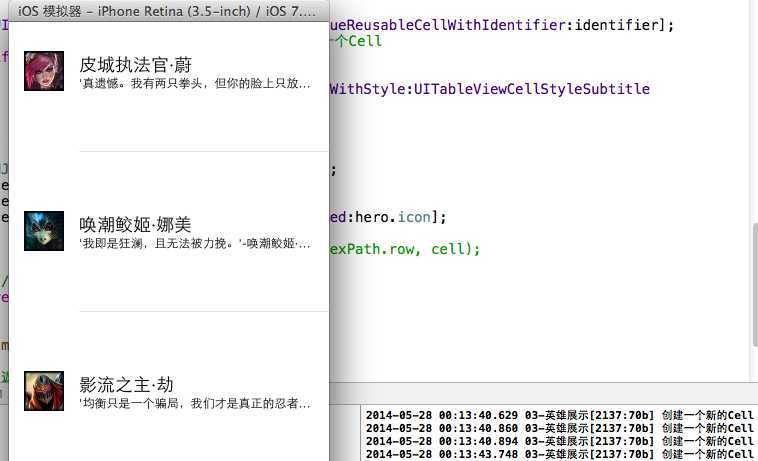标签:c style class blog code java
iOS开发UI篇—UITableviewcell的性能问题
一、UITableviewcell的一些介绍
UITableView的每一行都是一个UITableViewCell,通过dataSource的 tableView:cellForRowAtIndexPath:方法来初始化每?行
UITableViewCell内部有个默认的子视图:contentView,contentView是UITableViewCell所显示内容的父视图,可显示一些辅助指示视图
辅助指示视图的作?是显示一个表示动作的图标,可以通过设置UITableViewCell的 accessoryType来显示,默认是UITableViewCellAccessoryNone(不显?示辅助指?示视图), 其他值如下:
UITableViewCellAccessoryDisclosureIndicator
UITableViewCellAccessoryDetailDisclosureButton
UITableViewCellAccessoryCheckmark
还可以通过cell的accessoryView属性来自定义辅助指示视图(?如往右边放一个开关)
二、问题
cell的工作:在程序执行的时候,能看到多少条,它就创建多少条数据,如果视图滚动那么再创建新显示的内容。(系统自动调用)。即当一个cell出现在视野范围内的时候,就会调用创建一个cell。这样的逻辑看上去没有什么问题,但是真的没有任何问题吗?
当创建调用的时候,我们使用nslog打印消息,并打印创建的cell的地址。我们发现如果数据量非常大,用户在短时间内来回滚动的话,那么会创建大量的cell,一直开辟空间,且如果是往回滚,通过打印地址,我们会发现它并没有重用之前已经创建的cell,而是重新创建,开辟新的存储空间。
那有没有什么好的解决办法呢?
三、cell的重用原理
(1) iOS设备的内存有限,如果用UITableView显示成千上万条数据,就需要成千上万 个UITableViewCell对象的话,那将会耗尽iOS设备的内存。要解决该问题,需要重用UITableViewCell对象
(2)重?原理:当滚动列表时,部分UITableViewCell会移出窗口,UITableView会将窗口外的UITableViewCell放入一个对象池中,等待重用。当UITableView要求dataSource返回 UITableViewCell时,dataSource会先查看这个对象池,如果池中有未使用的 UITableViewCell,dataSource则会用新的数据来配置这个UITableViewCell,然后返回给 UITableView,重新显示到窗口中,从而避免创建新对象 。这样可以让创建的cell的数量维持在很低的水平,如果一个窗口中只能显示5个cell,那么cell重用之后,只需要创建6个cell就够了。
(3)注意点:还有?个非常重要的问题:有时候需要自定义UITableViewCell(用?个子类继 承UITableViewCell),而且每?行?的不一定是同一种UITableViewCell,所以一 个UITableView可能拥有不同类型的UITableViewCell,对象池中也会有很多不同类型的 UITableViewCell,那么UITableView在重?用UITableViewCell时可能会得到错误类型的 UITableViewCell
解决?方案:UITableViewCell有个NSString *reuseIdentifier属性,可以在初始化UITableViewCell的时候传入一个特定的字符串标识来设置reuseIdentifier(一般用UITableViewCell的类名)。当UITableView要求dataSource返回UITableViewCell时,先 通过一个字符串标识到对象池中查找对应类型的UITableViewCell对象,如果有,就重用,如果没有,就传入这个字符串标识来初始化?一个UITableViewCell对象。
图片示例:

说明:一个窗口放得下(可视)三个cell,整个程序只需要创建4个该类型的cell即可。
四、cell的优化代码
代码示例:
1 #import "NJViewController.h" 2 #import "NJHero.h" 3 4 // #define ID @"ABC" 5 6 @interface NJViewController ()<UITableViewDataSource, UITableViewDelegate> 7 /** 8 * 保存所有的英雄数据 9 */ 10 @property (nonatomic, strong) NSArray *heros; 11 @property (weak, nonatomic) IBOutlet UITableView *tableView; 12 13 @end 14 15 @implementation NJViewController 16 17 #pragma mark - 懒加载 18 - (NSArray *)heros 19 { 20 if (_heros == nil) { 21 // 1.获得全路径 22 NSString *fullPath = [[NSBundle mainBundle] pathForResource:@"heros" ofType:@"plist"]; 23 // 2.更具全路径加载数据 24 NSArray *dictArray = [NSArray arrayWithContentsOfFile:fullPath]; 25 // 3.字典转模型 26 NSMutableArray *models = [NSMutableArray arrayWithCapacity:dictArray.count]; 27 for (NSDictionary *dict in dictArray) { 28 NJHero *hero = [NJHero heroWithDict:dict]; 29 [models addObject:hero]; 30 } 31 // 4.赋值数据 32 _heros = [models copy]; 33 } 34 // 4.返回数据 35 return _heros; 36 } 37 38 - (void)viewDidLoad 39 { 40 [super viewDidLoad]; 41 // 设置Cell的高度 42 // 当每一行的cell高度一致的时候使用属性设置cell的高度 43 self.tableView.rowHeight = 160; 44 } 45 46 #pragma mark - UITableViewDataSource 47 // 返回多少组 48 - (NSInteger)numberOfSectionsInTableView:(UITableView *)tableView 49 { 50 return 1; 51 } 52 // 返回每一组有多少行 53 - (NSInteger) tableView:(UITableView *)tableView numberOfRowsInSection:(NSInteger)section 54 { 55 return self.heros.count; 56 } 57 // 当一个cell出现视野范围内的时候就会调用 58 // 返回哪一组的哪一行显示什么内容 59 - (UITableViewCell *)tableView:(UITableView *)tableView cellForRowAtIndexPath:(NSIndexPath *)indexPath 60 { 61 // 定义变量保存重用标记的值 62 static NSString *identifier = @"hero"; 63 64 // 1.先去缓存池中查找是否有满足条件的Cell 65 UITableViewCell *cell = [tableView dequeueReusableCellWithIdentifier:identifier]; 66 // 2.如果缓存池中没有符合条件的cell,就自己创建一个Cell 67 if (cell == nil) { 68 // 3.创建Cell, 并且设置一个唯一的标记 69 cell = [[UITableViewCell alloc] initWithStyle:UITableViewCellStyleSubtitle reuseIdentifier:identifier]; 70 NSLog(@"创建一个新的Cell"); 71 } 72 // 4.给cell设置数据 73 NJHero *hero = self.heros[indexPath.row]; 74 cell.textLabel.text = hero.name; 75 cell.detailTextLabel.text = hero.intro; 76 cell.imageView.image = [UIImage imageNamed:hero.icon]; 77 78 // NSLog(@"%@ - %d - %p", hero.name, indexPath.row, cell); 79 80 // 3.返回cell 81 return cell; 82 } 83 84 #pragma mark - 控制状态栏是否显示 85 /** 86 * 返回YES代表隐藏状态栏, NO相反 87 */ 88 - (BOOL)prefersStatusBarHidden 89 { 90 return YES; 91 } 92 @end
缓存优化的思路:
(1)先去缓存池中查找是否有满足条件的cell,若有那就直接拿来
(2)若没有,就自己创建一个cell
(3)创建cell,并且设置一个唯一的标记(把属于“”的给盖个章)
(4)给cell设置数据
注意点:
定义变量用来保存重用标记的值,这里不推荐使用宏(#define来处理),因为该变量只在这个作用域的内部使用,且如果使用宏定义的话,定义和使用位置太分散,不利于阅读程序。由于其值不变,没有必要每次都开辟一次,所以用static定义为一个静态变量。
iOS开发UI篇—UITableviewcell的性能问题,布布扣,bubuko.com
标签:c style class blog code java
原文地址:http://www.cnblogs.com/wendingding/p/3756257.html